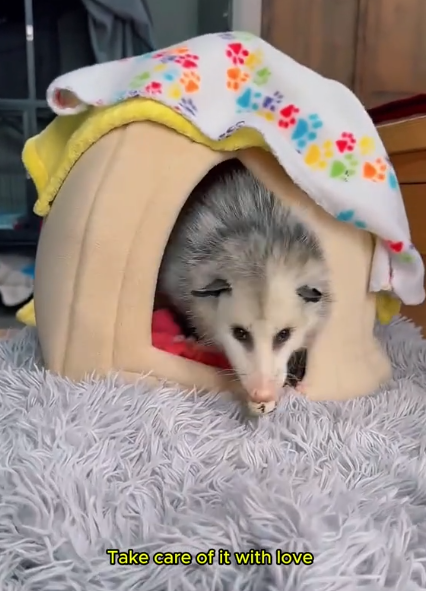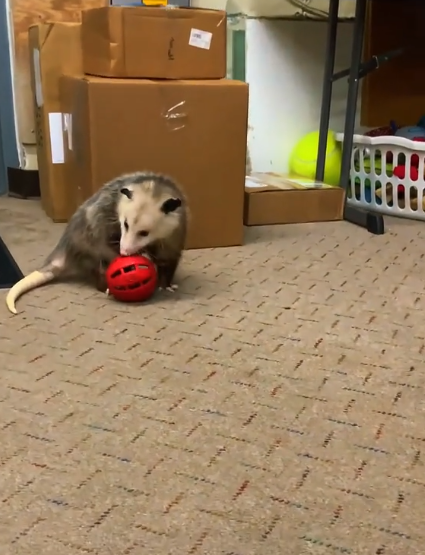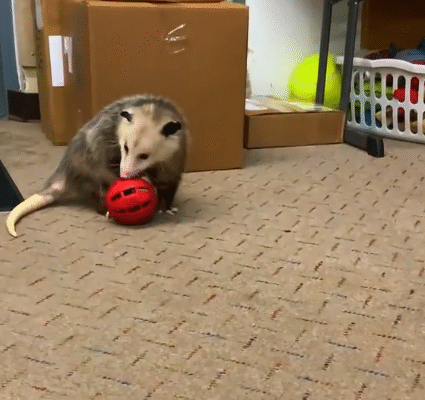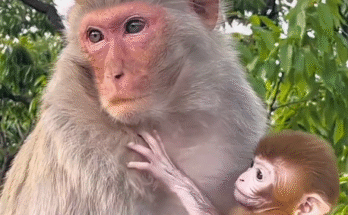
It all started on a quiet Sunday morning. The sun had just begun to rise, casting a golden hue across the landscape. The air was crisp, and the streets were nearly empty. I had decided to take a walk through the park, hoping to clear my mind and enjoy a bit of peace before the start of a busy week. Little did I know, I was about to have an unexpected encounter that would remind me of the importance of compassion and the value of every living creature.
As I strolled down the gravel path lined with oak and maple trees, I noticed something unusual near the side of the trail. At first glance, I thought it might be a discarded piece of clothing or a bag. But as I got closer, I saw a small, gray-furred animal curled up beside the bushes. Its body was trembling slightly, and its tiny pink nose twitched weakly.
It was an opossum—young, injured, and clearly in distress.
I knelt down slowly, careful not to frighten it. Its eyes were half-open, and there was a small patch of blood on its side. One of its hind legs was twisted at an odd angle, and its breathing was shallow. I looked around, hoping to find a sign of how it had gotten hurt. There were no other animals nearby, but a few small tire tracks on the nearby grass suggested it might have been hit by a bicycle or even a car that veered off the road.
My heart ached for the little creature. Many people would have walked right past it—or worse, seen it as a nuisance. But in that moment, all I saw was a living being that needed help.
I took off my jacket and gently wrapped the opossum in it, doing my best not to cause more pain. It didn’t struggle—perhaps it knew I meant no harm, or perhaps it was simply too weak. I held it close to my chest to keep it warm and immediately headed home.
Once there, I placed the opossum in a soft towel inside a cardboard box and gave it a few drops of water using a small plastic syringe. Then, I called a nearby wildlife rehabilitation center to explain the situation. They advised me to bring it in as soon as possible and to keep it warm and quiet in the meantime.
The drive to the center felt longer than it was. I kept glancing at the box in the passenger seat, silently urging the little creature to hang on. It shifted slightly every now and then, letting out the tiniest whimpers. I whispered softly, reassuring it that it would be okay.

When I arrived, a kind-faced vet named Dr. Julia greeted me. She carefully examined the opossum and confirmed that its leg was broken and that it had suffered some internal bruising, likely from being hit or crushed. But the good news was that the injuries were treatable—and it had a strong chance of recovery.
For the next few weeks, I visited the rehabilitation center regularly. I named the opossum “Olive.” Dr. Julia said it was likely a young female, no older than six months. Despite the pain she must have been in, Olive slowly began to show signs of improvement. Her leg was set in a small splint, and she received fluids and medications to help her heal. With each visit, I could see her gaining strength. Her eyes became brighter, her breathing steadier.
One day, during a visit, I was allowed to feed her small pieces of fruit. She nibbled on a slice of banana, and for the first time, I saw her tail flick with something that looked like contentment. It was a small gesture, but it filled me with hope.
In learning more about opossums during this time, I discovered how misunderstood they often are. Many people think of them as dirty or aggressive, but in truth, opossums are gentle, shy creatures. They help control insect populations, eat ticks by the thousands, and rarely carry diseases like rabies due to their low body temperatures. They’re nature’s quiet little helpers, and yet so few recognize their worth.
After nearly six weeks of care, Dr. Julia declared that Olive was ready to return to the wild. Her leg had healed beautifully, and she was moving with ease. Though she had become accustomed to human interaction, she still maintained the cautious, independent nature of a wild animal—a good sign that she was ready to fend for herself.
The release day was bittersweet. I had grown attached to Olive, but I knew that returning to her natural habitat was the best gift I could give her. We chose a wooded area near the park where I had first found her—far from traffic and full of trees and hiding spots.
As I opened the box, Olive hesitated for a moment. She sniffed the air, then slowly climbed out and looked around. With surprising agility, she trotted into the underbrush, her tail swaying behind her like a banner of triumph. She didn’t look back, and that was okay. She was free.

I stood there for a while, staring at the spot where she disappeared. The forest was quiet again, but my heart felt full. Rescuing Olive had been a small act in the grand scheme of things, but for her, it meant everything. And for me, it was a powerful reminder of how one moment of kindness can ripple out and make a lasting difference.
Since then, I’ve become more involved in local wildlife efforts. I’ve volunteered at the same rehabilitation center and even set up a small “wildlife first aid” kit at home, just in case. I also share Olive’s story with others—hoping to change how people view opossums and other often-overlooked animals.
Life is full of unexpected encounters. Sometimes they come in the form of a challenge, a test of compassion. Other times, they offer the chance to be a hero in someone else’s story—even if that someone is small, scared, and covered in fur. That Sunday morning walk could have ended without incident. But I’m so glad it didn’t.
Because I rescued a poor, injured opossum—and in doing so, found something gentle and important within myself too.



